Inhibition of the cation channel TRPV4 improves bladder function in mice and rats with cyclophosphamide-induced cystitis
- PMID: 20956320
- PMCID: PMC2973867
- DOI: 10.1073/pnas.1005333107
Inhibition of the cation channel TRPV4 improves bladder function in mice and rats with cyclophosphamide-induced cystitis
Abstract
Reduced functional bladder capacity and concomitant increased micturition frequency (pollakisuria) are common lower urinary tract symptoms associated with conditions such as cystitis, prostatic hyperplasia, neurological disease, and overactive bladder syndrome. These symptoms can profoundly affect the quality of life of afflicted individuals, but available pharmacological treatments are often unsatisfactory. Recent work has demonstrated that the cation channel TRPV4 is highly expressed in urothelial cells and plays a role in sensing the normal filling state of the bladder. In this article, we show that the development of cystitis-induced bladder dysfunction is strongly impaired in Trpv4(-/-) mice. Moreover, we describe HC-067047, a previously uncharacterized, potent, and selective TRPV4 antagonist that increases functional bladder capacity and reduces micturition frequency in WT mice and rats with cystitis. HC-067047 did not affect bladder function in Trpv4(-/-) mice, demonstrating that its in vivo effects are on target. These results indicate that TRPV4 antagonists may provide a promising means of treating bladder dysfunction.
Conflict of interest statement
Conflict of interest statement: All authors from Hydra Biosciences, except for C.R.M., are current employees, and all are granted stock options in that company.
Figures
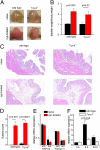

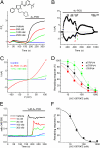
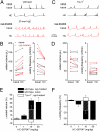
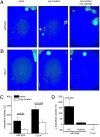
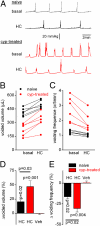
Similar articles
-
Intravesical TRPV4 blockade reduces repeated variate stress-induced bladder dysfunction by increasing bladder capacity and decreasing voiding frequency in male rats.Am J Physiol Regul Integr Comp Physiol. 2014 Aug 15;307(4):R471-80. doi: 10.1152/ajpregu.00008.2014. Epub 2014 Jun 25. Am J Physiol Regul Integr Comp Physiol. 2014. PMID: 24965792 Free PMC article.
-
Carbenoxolone inhibits TRPV4 channel-initiated oxidative urothelial injury and ameliorates cyclophosphamide-induced bladder dysfunction.J Cell Mol Med. 2017 Sep;21(9):1791-1802. doi: 10.1111/jcmm.13100. Epub 2017 Feb 28. J Cell Mol Med. 2017. PMID: 28244642 Free PMC article.
-
TRPV4 blockade reduces voiding frequency, ATP release, and pelvic sensitivity in mice with chronic urothelial overexpression of NGF.Am J Physiol Renal Physiol. 2019 Dec 1;317(6):F1695-F1706. doi: 10.1152/ajprenal.00147.2019. Epub 2019 Oct 21. Am J Physiol Renal Physiol. 2019. PMID: 31630542 Free PMC article.
-
Emerging roles of the TRPV4 channel in bladder physiology and dysfunction.J Physiol. 2021 Jan;599(1):39-47. doi: 10.1113/JP279776. Epub 2020 Oct 27. J Physiol. 2021. PMID: 33052604 Free PMC article. Review.
-
Cystitis: from urothelial cell biology to clinical applications.Biomed Res Int. 2014;2014:473536. doi: 10.1155/2014/473536. Epub 2014 Apr 30. Biomed Res Int. 2014. PMID: 24877098 Free PMC article. Review.
Cited by
-
Activation of MrgprA3 and MrgprC11 on Bladder-Innervating Afferents Induces Peripheral and Central Hypersensitivity to Bladder Distension.J Neurosci. 2021 Apr 28;41(17):3900-3916. doi: 10.1523/JNEUROSCI.0033-21.2021. Epub 2021 Mar 16. J Neurosci. 2021. PMID: 33727332 Free PMC article.
-
Ouabain's Influence on TRPV4 Channels of Epithelial Cells: An Exploration of TRPV4 Activity, Expression, and Signaling Pathways.Int J Mol Sci. 2023 Nov 24;24(23):16687. doi: 10.3390/ijms242316687. Int J Mol Sci. 2023. PMID: 38069012 Free PMC article.
-
Small molecule dual-inhibitors of TRPV4 and TRPA1 for attenuation of inflammation and pain.Sci Rep. 2016 Jun 1;6:26894. doi: 10.1038/srep26894. Sci Rep. 2016. PMID: 27247148 Free PMC article.
-
Immunohistochemistry as a paramount tool in research of normal urothelium, bladder cancer and bladder pain syndrome.Eur J Histochem. 2021 Mar 24;65(2):3242. doi: 10.4081/ejh.2021.3242. Eur J Histochem. 2021. PMID: 33764020 Free PMC article. Review.
-
Urothelial signaling.Physiol Rev. 2013 Apr;93(2):653-80. doi: 10.1152/physrev.00030.2012. Physiol Rev. 2013. PMID: 23589830 Free PMC article. Review.
References
-
- Andersson KE, Arner A. Urinary bladder contraction and relaxation: physiology and pathophysiology. Physiol Rev. 2004;84:935–986. - PubMed
-
- Ouslander JG. Management of overactive bladder. N Engl J Med. 2004;350:786–799. - PubMed
-
- Abrams P, et al. The standardisation of terminology of lower urinary tract function: Report from the Standardisation Sub-committee of the International Continence Society. Am J Obstet Gynecol. 2002;187:116–126. - PubMed
-
- Kannan H, Radican L, Turpin RS, Bolge SC. Burden of illness associated with lower urinary tract symptoms including overactive bladder/urinary incontinence. Urology. 2009;74:34–38. - PubMed
Publication types
MeSH terms
Substances
LinkOut - more resources
Full Text Sources
Other Literature Sources
Molecular Biology Databases

